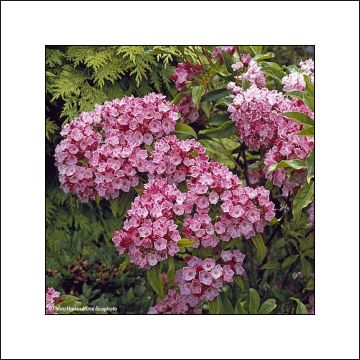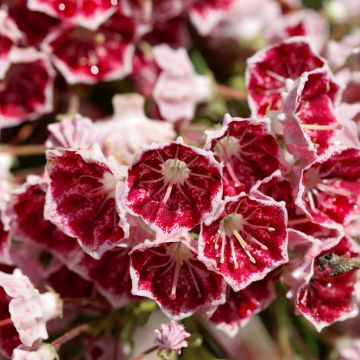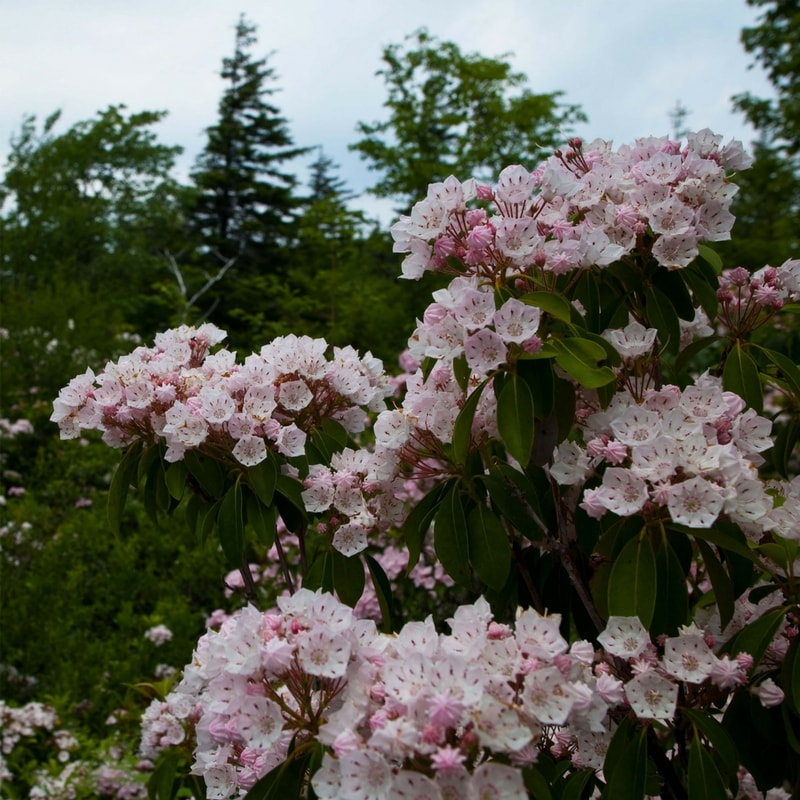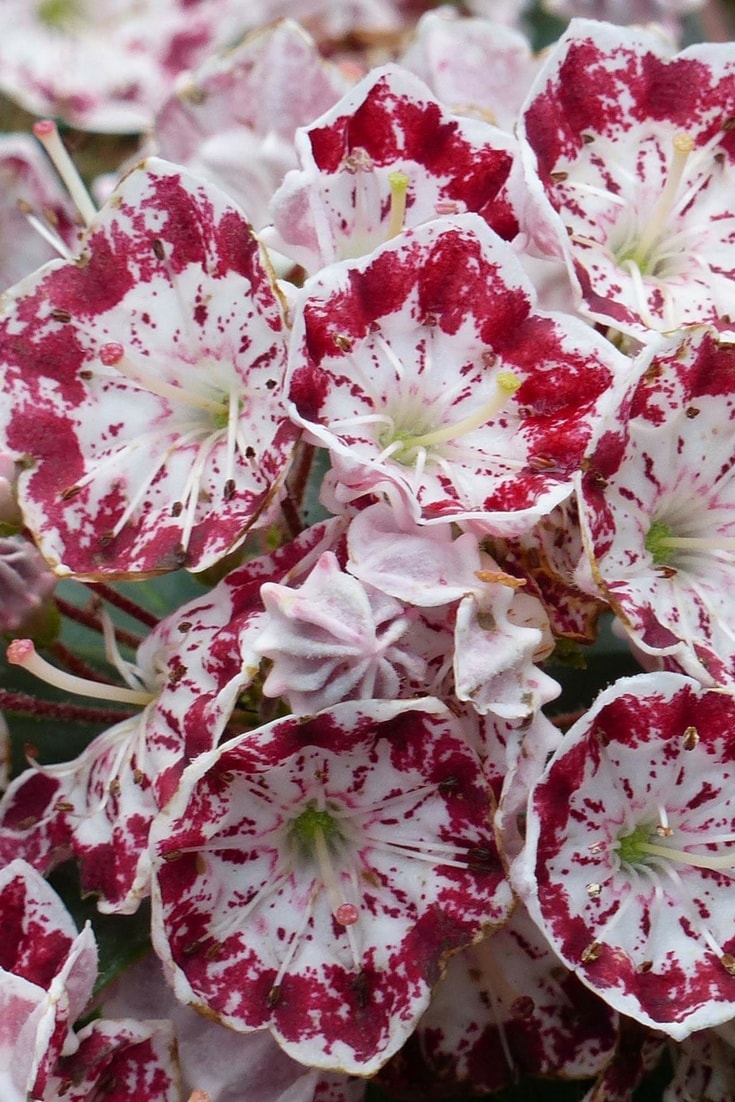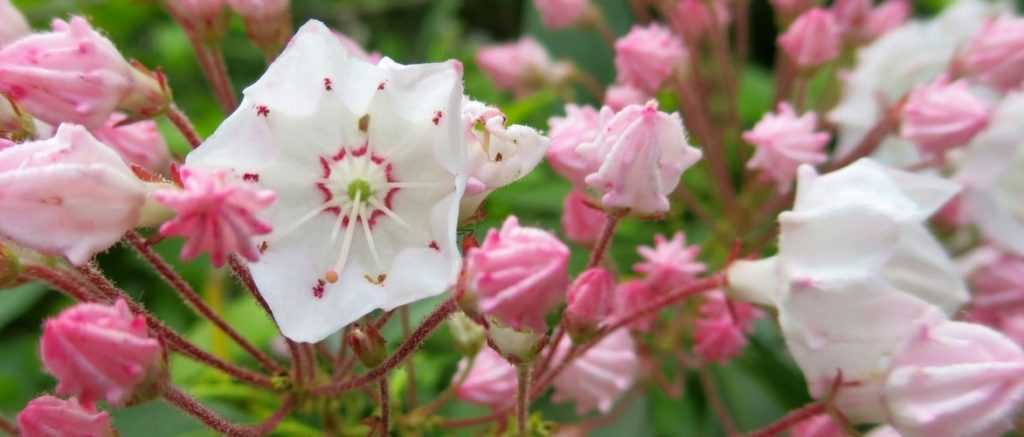
Kalmia latifolia: Planting, Growing and Care
Contents
In a few words
- In May-June, it adorns itself with a multitude of flowers whose corollas display unparalleled delicacy
- It thrives in shade and acidic conditions: it flourishes in partial shade and in heather soil
- It retains its beautiful, glossy evergreen foliage all year round
- Though very slow-growing, it is exceptionally hardy, tolerating temperatures down to -30°C
- Versatile, it can be used in borders, as a standalone specimen or in containers
Our expert's word
While the Kalmia latifolia is widely known as a homeopathic remedy for pain relief, the Kalmia, also called Mountain Laurel or American Laurel, is a beautiful, hardy shrub that remains unjustly overlooked. The most well-known species is Kalmia latifolia, which boasts numerous cultivars in varied hues. Its relative, Kalmia angustifolia, is more compact, rarely exceeding one metre in height. Less common, Kalmia microphylla is a dwarf species seldom cultivated in our gardens.
From April to May, Kalmia latifolia becomes adorned with clusters of pink buds resembling tiny meringues, which bloom into pale pink or white corollas of exquisite delicacy. Its glossy evergreen foliage provides the perfect backdrop for this fresh and abundant flowering.
Unique, it offers armfuls of bright flowers in spring, illuminating shaded corners.
More demanding than its cousin the Rhododendron, it shares the same acid-loving nature and requires ericaceous soil—loose, cool, and well-draining—to thrive.
This woodland dweller adapts well to light, acidic, cool but well-drained soil, where it grows very slowly beneath tree cover, sheltered from cold winds and stagnant moisture.
With its modest size and dense, bushy habit, it suits any garden setting. It works wonders in perennial borders, as a standalone specimen, or even in containers on a shaded terrace. It is the ideal companion for other ericaceous plants such as Rhododendrons, Azaleas, Camellias, Heathers, Hydrangeas, Pieris…
Exceptionally floriferous and evergreen, the Kalmia ranks among the most beautiful ericaceous shrubs. Explore our wide selection and let yourself be charmed by its singular blooms!
Botany
Botanical data
- Latin name Kalmia
- Family Ericaceae
- Common name Mountain laurel, American laurel, Calico bush
- Flowering May-June
- Height 0.30 cm for dwarf species up to 3 metres for the tallest
- Exposure sun, partial shade
- Soil type Ericaceous (Acidic)
- Hardiness -30°C
Kalmia is an evergreen shrub belonging to the Ericaceae family, like Heather and Rhododendron. Also known as Mountain laurel or American laurel, it originates from the forests, swamps and meadows of North America. The genus includes seven species, the most well-known being Kalmia latifolia which reaches 2 to 3 m in height in our gardens and has numerous cultivars with varied colours. Its relative, Kalmia angustifolia, more compact with a rounded habit, doesn’t exceed one metre in height and width. Less spectacular, Kalmia microphylla is a dwarf species (10 to 30 cm tall) that prefers damp and marshy areas.
Kalmia is a beautiful shrub with a bushy, dense, somewhat erect habit, more or less branched depending on the species, which can reach 2 to 3 m in height and spread (nearly 10 m in its natural habitat). Its trunk sometimes becomes twisted, especially with age. The very hard wood of its branches was once prized, particularly for making wooden spoons, hence its English nickname “Spoonwood”.
Slow to establish initially, Kalmia makes up for it with its longevity: some mother plants are around 60 years old! Its fine, shallow roots develop very slowly in the soil. As a result, it’s well suited to small gardens and urban gardens and can also be grown in containers on a terrace. It will take many years to form proper thickets (it grows about 1 m in ten years). Patience is rewarded by its truly unique flowering!
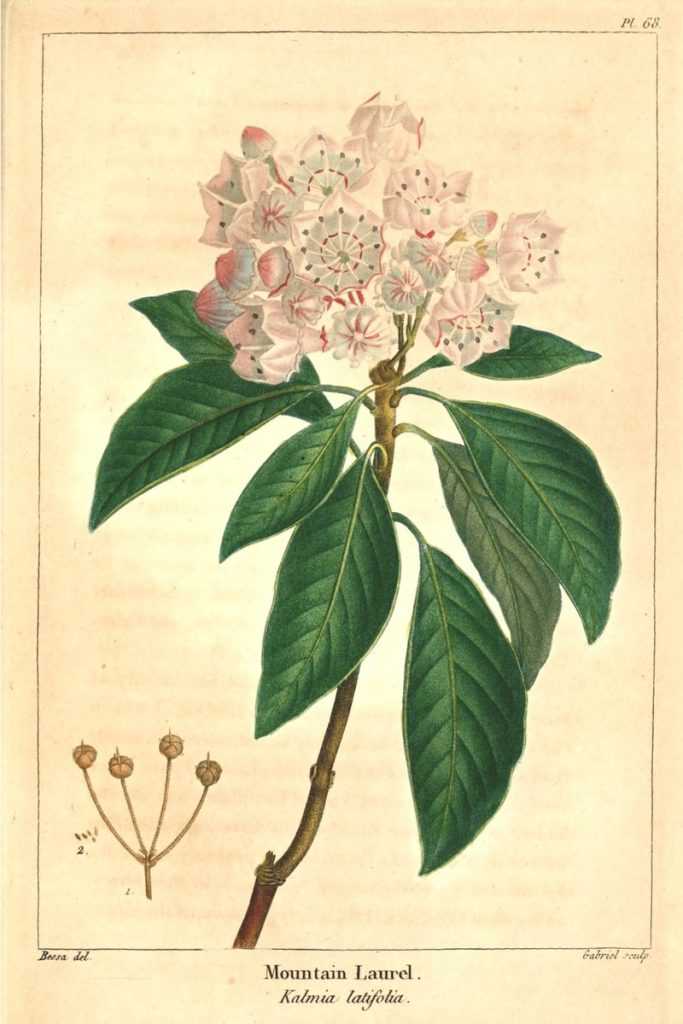
Kalmia latifolia: botanical illustration
Its spring flowering is enchanting! Between May and June, Kalmia becomes entirely covered with splendid flowers of very original design. This uniqueness has made the flower of Kalmia latifolia the emblem of the US states of Connecticut and Pennsylvania.
Emerging from dark pink or bright red pleated flower buds, the blooms resembling small sugar tulips open into flat, very flared or bell-shaped cups, 2 to 2.5 cm in diameter, formed of 5 petals that spread around a heart bordered by purple or golden-yellow stamens. They gather at the ends of branches in generous clusters that can bear up to a hundred flowers. Infinitely delicate, these slightly waxy corollas come in all shades of pink, ranging from white-pink, red, pale pink to purplish-pink in gradient with a darker reverse, evoking porcelain. Depending on the variety, these bell-shaped flowers take on a darker hue when mature or are veined with radiating bands like in Kalmia latifolia ‘You Can’. Some new cultivars like Kalmia latifolia ‘Tad’ even have surprisingly chocolate-coloured flowers.
An exquisite flowering that lasts a good month and is staggered: the beautifully ribbed flower buds resembling little meringues coexist with already opened flowers creating a pleasing contrast. Though unscented, they more than compensate for this lack of fragrance with their remarkable floriferousness.

Foliage, bud and flowers
After flowering, brown globular capsule-like fruits appear, persisting through winter.
Kalmia offers beautiful, graphic and elegant foliage all year round. It forms interesting bushy clumps for its evergreen foliage, somewhat similar to that of Rhododendron or Laurel. Its foliage consists of small glossy leaves 3 to 8 cm long, leathery and thick. Simple, alternate or opposite, lanceolate or elliptical depending on the variety, they form a permanent backdrop of intense glossy green. The branches of some varieties like Kalmia latifolia ‘Pinkobello’ take on reddish tones that contrast beautifully with the foliage.
Despite thick foliage and a robust clump, Kalmia fears three things: direct sun, cold winds and lime.
In nature, this heathland shrub thrives in partially shaded locations, on woodland edges where sunlight is filtered by trees. It appreciates sun exposure for a few hours in the morning or late afternoon.
While it tolerates a slight sea breeze, planting along a wall or in woodland, sheltered from cold, drying winds to preserve its evergreen foliage is essential. On the other hand, it isn’t afraid of cold. Kalmia is perfectly hardy and withstands temperatures down to -30°C, sometimes lower, provided it’s planted in a sheltered position.
Mountain laurel can be planted almost anywhere in France with a preference for cool, rainy oceanic climates: it likes coolness and high humidity.
While Kalmia is a low-maintenance shrub, it’s demanding regarding soil type. If the soil isn’t suitable, it will decline. Like its cousin the Rhododendron, Kalmia is a heathland shrub that absolutely needs acidic soil, rather cool, humus-rich but well-drained, and lime-free. Very sensitive to excess water, it fears stagnant moisture in heavy, asphyxiating soils.
The genus Kalmia is dedicated to Pehr Kalm, a famous 18th-century Swedish botanist who was one of the first to explore the flora in parts of North America.
Very versatile, Kalmia can be used in free hedges with other heathland shrubs, in beds with perennials, as a specimen plant and even in containers: plant taller varieties in a sheltered spot to create a free hedge or dress a wall, alongside Rhododendrons, Camellias, Azaleas, Pieris or Enkianthus. It will also be an ideal companion for Heathers, Hydrangeas, Japanese Maples and Magnolias. Its very slow growth and the modest size of some varieties allow it to be planted in containers: it will make a pretty decorative subject all year round with its evergreen glossy green foliage.
Species and varieties
The Kalmia genus includes seven species of varying sizes and flower colours. While the compact Kalmia angustifolia, wider than it is tall, can be found commercially, the most commonly cultivated species in our gardens—and certainly the best-known—is Kalmia latifolia, which boasts numerous cultivars in various shades of pink, most of which originate from North American breeding programmes.
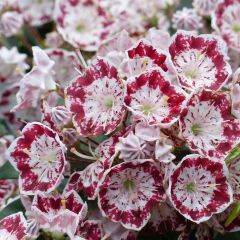
Kalmia latifolia Minuet - Mountain Laurel
- Flowering time June, July
- Height at maturity 1 m

Kalmia latifolia - Mountain Laurel
- Flowering time June, July
- Height at maturity 2 m
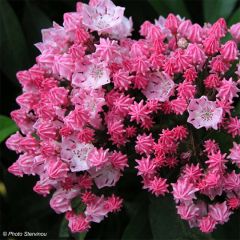
Kalmia latifolia You Can - Mountain Laurel
- Flowering time June, July
- Height at maturity 2 m

Kalmia latifolia Olympic Fire - Mountain Laurel
- Flowering time June, July
- Height at maturity 1 m
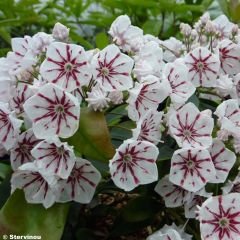
Kalmia latifolia Peppermint - Mountain Laurel
- Flowering time June, July
- Height at maturity 1,50 m
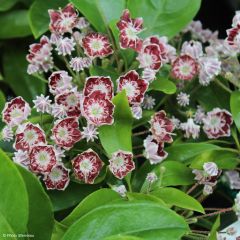
Kalmia latifolia Tad - Mountain Laurel
- Flowering time June, July
- Height at maturity 1 m
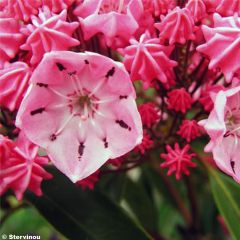
Kalmia latifolia Ewa - Mountain Laurel
- Flowering time June, July
- Height at maturity 1,30 m

Kalmia latifolia You Can - Mountain Laurel
- Flowering time June, July
- Height at maturity 2 m

Kalmia latifolia Minuet - Mountain Laurel
- Flowering time June, July
- Height at maturity 1 m

Kalmia latifolia Olympic Fire - Mountain Laurel
- Flowering time June, July
- Height at maturity 1 m
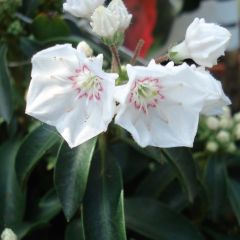
Kalmia latifolia Elf - Mountain Laurel
- Flowering time June, July
- Height at maturity 75 cm
- Kalmia angustifolia f. ‘rubra’ or Sheep Laurel: A smaller variety (0.80 cm) with deep red-purple flowers appearing slightly later in June-July.
- Kalmia latifolia ‘Ostbo Red’: Glossy green foliage sets off bright red buds that open into pale pink flowers. Very compact.
- Kalmia latifolia ‘Carousel’: White flowers streaked with intricate red patterns.
- Kalmia latifolia f. fuscata ‘Freckles’: A cinnamon-purple ring marks the interior of the white corolla.
Discover other Kalmias
Planting Kalmia
Where to plant?
Kalmia needs shade and acidity to thrive. It dislikes scorching sun and even more so… icy winds that damage its foliage. These are all factors to consider when planting it in your garden.
This shrub can be planted almost anywhere in France, except perhaps south of the Loire, as it dislikes intense sun in hot regions. It prefers soil that remains cool. It has a preference for cool, rainy climates, such as that of Brittany, where it grows very vigorously. In the wild, most heathland plants grow in woodland or woodland edges, where humidity is high. It can tolerate a few hours of sun in the morning or late afternoon.
It thrives in a shaded spot in the garden, sheltered from direct sunlight, along a wall or under the dappled shade of tall trees. Avoid overly dense shade, as it needs light to flower well. Ideally, it prefers west, southwest or northwest-facing exposures.
Very hardy, Kalmia is not afraid of cold, tolerating temperatures down to -20°C and coastal air, but dislikes storms and cold winds, which scorch its evergreen foliage: planting it in a sheltered spot away from cold draughts is essential.
Easy to grow, Kalmia is nevertheless particular about soil type: it needs acidity! It is an acid-loving plant that requires acidic soil, ideally close to heathland soil and free from lime.
It also dislikes heavy, compact, waterlogged soils and grows best in cool, even moist, but well-drained conditions: Kalmia is very sensitive to excess water, so avoid waterlogged areas, especially in winter. Excess moisture encourages infection by Phytophthora, a soil-borne fungus that can kill the plant suddenly and completely.
If your soil is too chalky and/or too heavy, it’s best to improve it with heathland soil or… simply accept that Kalmia is not suited to your garden. Instead, opt for a less demanding shrub, otherwise you’ll need frequent applications of heathland soil and may end up with a weak plant prone to fungal attacks.
You can also grow it in a pot. Its compact size makes it ideal for container growing. It will thrive for many years in a large pot filled with two-thirds heathland soil and one-third good, lime-free garden soil, kept consistently moist.
Highly versatile in the garden, Kalmia works well in mixed borders with perennials, woodland edges, informal hedges, as a standalone specimen or in pots on a shaded terrace. Plant taller varieties in a sheltered, wooded spot to fill out a hedge, while low-growing varieties like Kalmia latifolia ‘Minuet’ suit cool rockeries or partially shaded borders. Very slow-growing, it’s a compact shrub, ideal for small gardens or urban spaces.
When to plant?
Kalmia can be planted year-round, avoiding frost and drought periods. Ideally, for best establishment, plant in autumn (September–November) in warm regions, or in spring (April–May) elsewhere.
How to plant?
Planting is the crucial step! The secret lies in soil quality.
- Avoid chalky soil: it won’t survive. If you still want to try: replace the excavated soil with a mix of heathland soil, leaf mould and peat. Chalky soils cause yellowing foliage (chlorosis), often leading to the plant’s death. Alternatively, line the planting hole with a plant-friendly membrane to prevent lime from leaching in.
- Avoid waterlogged areas: add gravel, pumice or clay pebbles to the base of the hole for drainage (its roots dislike stagnant moisture, especially in winter, and are prone to Phytophthora).
- Dig a hole 5–10 times wider than the root ball and 50 cm deep.
- Plant the shrub at soil level, in an ideal mix of 1/5 garden soil blended equally with peat, heathland soil, leaf mould and pumice.
- Apply an 8–10 cm organic mulch of pine bark or plant small perennials around the base to retain moisture and reduce watering: it likes its roots kept cool in summer.
- Water regularly with lime-free water (rainwater), but not excessively, for the first few weeks to keep the soil moist. In the first year, water generously during summer droughts.
Container gardening
The Kalmia is a shrub that is very well suited to container growing. We recommend opting for dwarf varieties such as Kalmia latifolia ‘Minuet’. It is essential to use a fresh, very well-draining mix, based on genuine ericaceous compost and well-rotted leaf mould, as it cannot tolerate waterlogged conditions. Choose a large container of around 30 litres (30 to 40 cm in diameter) and place a layer of gravel or clay pebbles at the bottom. When grown in pots, it will not tolerate even brief periods of drought. Kalmia requires water year-round, and if grown in a container, careful monitoring of watering will be essential. Apply a mulch or plant small perennials like dwarf cyclamen to help retain moisture.
Maintenance, Pruning and Care
An established Kalmia requires little care to maintain its good health. Each spring, at the end of winter, you can lightly fork in some compost around the base to maintain soil fertility. You may also apply a fertiliser specially formulated for ericaceous plants.
Then spread a layer of organic mulch (pine bark or needles, leaf mould), renewed annually, to keep its roots cool during summer heat.
Kalmia needs water in summer but dislikes waterlogged conditions in winter. In summer: water 2-3 times per month, no more, using lime-free water. For this lime-intolerant plant, rainwater is preferable.
Being slow-growing, pruning is unnecessary. Only intervene to remove any dead branches or for very light shaping to maintain a balanced form. Remove faded flowers after blooming to prevent seed formation which exhausts the plant.
Possible diseases
When grown under good conditions, Kalmia shows little susceptibility to diseases and pests.
It is mainly vulnerable to fungal diseases caused by moulds. These issues usually stem from poorly drained soil or stagnant moisture around the roots. Its main enemy: Phytophthora, a soil-borne fungus whose attack can kill it as suddenly as it is devastating.
Phytophthora, literally meaning “plant destroyer” in Greek, thrives in persistently damp conditions, often due to overwatering. The foliage discolours, turns brown or red, then withers. The plant then dies rapidly. There is no treatment, but these problems are rare if proper growing advice is followed: plant in healthy soil, avoid waterlogged conditions, and improve drainage. If, despite these precautions, an attack occurs: remove affected plants and the surrounding soil. Never replant susceptible species in the same spot.
Intolerant to lime, Kalmia leaves discolour and turn yellow in case of excess lime (chlorosis). The culprit may simply be the watering water. Water only with rainwater.
Propagation
- By semi-ripe cuttings
After flowering, in July-August, take 10-20 cm long semi-woody or semi-ripe cuttings (i.e., from stems that grew in spring and begin their transformation from softwood to hardwood from July-August). Plant them in a light, well-draining growing medium. Regularly mist the cuttings with a sprayer. Pot them up as soon as they have formed roots. Overwinter them frost-free: a constant temperature of at least 20°C is essential for rooting within 8 to 10 weeks. Plant out in the ground the following spring if the root system is sufficiently developed.
- By softwood cuttings
Softwood cuttings are generally taken in spring, in May. Cut a stem below a leaf or bud. Remove the lower leaves. Plant in pots or trays in a growing medium composed of garden soil and river sand. Keep the cuttings regularly moist and maintain them under cover with a temperature of at least 20°C. Transplant them into individual pots, then into the ground when the root system is sufficiently developed. Several overwintering periods may be necessary.
- By layering
While layering is the least labor-intensive method to propagate Kalmia, you’ll need patience: root development is very slow. In August, bend one of its stems towards the ground, burying a portion to encourage rooting. Stake the aerial part. In autumn or the following spring, you can separate the layer from the parent plant once it has sufficient roots, by cutting the stem where it enters the ground.
Pairing Kalmia
Highly versatile, the Kalmia can be used in a mixed hedge with other ericaceous shrubs, in borders with perennials, as a standalone feature, or even in pots: plant taller varieties in a sheltered spot to create an informal hedge or adorn a wall, alongside Rhododendrons, Camellias, Azaleas, or Enkianthus. It also makes an ideal companion for Heathers, Hydrangeas, Hydrangeas, Japanese Maples, Magnolias, Pieris, Sarcococcas, Daphnes, or Skimmias.

Pair the pale pink Kalmia with Magnolia Fairy Blush® (Michelia hybrid) or Magnolia sieboldii
Its very slow growth and the modest size of some varieties make it suitable for planting in pots: it will be a lovely decorative feature all year round with its glossy evergreen foliage.
→ Discover more ideas for pairing with Kalmia in our advice sheet!
Useful resources
- Discover our tips for successfully growing Kalmia in pots
- What to pair with your Kalmia? Choose from our range of ericaceous plants
- Our planting guide is perfect for learning how to plant ericaceous shrubs correctly
- The finest selection of Kalmia can be found here
- 5 essential tips for successful ericaceous shrubs: on our blog, our Head Gardener Michaël shares his secrets
Frequently asked questions
-
I have heavy and slightly chalky soil, can I still plant a Kalmia?
Yes, but it's not a sure thing! Kalmia is a heathland shrub, a cousin of the Rhododendron, which thrives where there is no lime. Its leaves discolour and turn yellow in case of excess lime (chlorosis). It also dislikes heavy, compact soils that are waterlogged, especially in winter. It prefers light, cool soils in summer. Excess water encourages contamination by Phytophthora, whose attack can kill it as suddenly as it is devastating. If your soil is too lime-rich and/or too heavy, opt instead for a shrub that is less demanding in terms of soil type, otherwise you may have to make frequent additions of heathland soil, only to end up with a weak specimen prone to disease. If, despite this, you wish to attempt growing it, prepare the soil with a substrate composed of equal parts heathland soil or peat, compost and topsoil, and line the bottom and sides of the planting hole with a plant felt to prevent lime from rising.
-
My Kalmia hasn't grown in two years since planting!
That's normal. Kalmia is very slow to establish itself: its roots develop very slowly in the soil. You'll need to wait many years to see it form a proper shrub, as it grows roughly 1 metre in ten years. Your patience will be rewarded by its truly unique flowering display!
-
My Kalmia died suddenly after two years, why?
Several explanations are possible. It may have died from overwatering, as its roots cannot tolerate stagnant moisture which encourages the proliferation of *Phytophthora*, a fungus whose attack can kill it as suddenly as it is devastating. It may be getting too much sun: dappled light is all it needs to thrive. It dislikes scorching sunlight during the hottest hours of the day. Move it to partial shade, where sunlight is filtered by tall trees.
-
My Kalmia is struggling, losing its leaves which turn yellow before falling off. Why?
The Kalmia appreciates being fed annually with decomposed compost and leaf mould on the surface, as the soil may be too poor for it. Intolerant to lime, its leaves discolour and turn yellow in case of excess lime (chlorosis). The culprit might simply be the watering water. Water only with rainwater.
- Subscribe!
- Contents





































